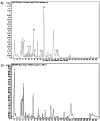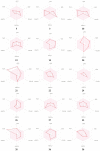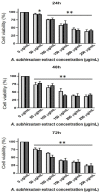Allium subhirsutum L. as a Potential Source of Antioxidant and Anticancer Bioactive Molecules: HR-LCMS Phytochemical Profiling, In Vitro and In Vivo Pharmacological Study
- PMID: 33081189
- PMCID: PMC7602730
- DOI: 10.3390/antiox9101003
Allium subhirsutum L. as a Potential Source of Antioxidant and Anticancer Bioactive Molecules: HR-LCMS Phytochemical Profiling, In Vitro and In Vivo Pharmacological Study
Abstract
This study investigated Allium subhirsutum L. (AS) anticancer and antioxidant effects and inhibition of tumor angiogenesis in a murine model of skeletal metastases due to inoculation of Walker 256/B cells. Phytochemical composition of AS extract (ASE) was studied by High Resolution-Liquid Chromatography Mass Spectroscopy (HR-LCMS). Total phenolic and flavonoid contents (TPC and TFC) were determined. In vitro, the antioxidant properties were evaluated by reducing power and antiradical activity against DPPH. Cancer cells' proliferation, apoptosis, metastatic development and angiogenesis were evaluated using Walker 256/B and MatLyLu cells. The p-coumaric acid was the major phenolic acid (1700 µg/g extract). ASE showed high levels of TPC and TFC and proved potent antioxidant effects. ASE inhibited Walker 256/B and MatLyLu cells' proliferation (Half-maximal inhibitory concentration: IC50 ≃ 150 µg/mL) and induced apoptosis. In silico and in vivo assays confirmed these findings. ASE effectively acts as a chemo-preventive compound, induces apoptosis and attenuates angiogenesis and osteolytic metastases due to Walker 256/B malignant cells.
Keywords: Allium subhirsutum; angiogenesis; anticancer; antioxidant; apoptosis; bone metastases; cell proliferation; phytochemistry.
Conflict of interest statement
The authors declare no conflict of interest. The funder had no role in the design of the study; in the collection, analyses, or interpretation of data; in the writing of the manuscript, or in the decision to publish the results.
Figures







Similar articles
-
Phytochemical Profiling of Allium subhirsutum L. Aqueous Extract with Antioxidant, Antimicrobial, Antibiofilm, and Anti-Quorum Sensing Properties: In Vitro and In Silico Studies.Plants (Basel). 2022 Feb 11;11(4):495. doi: 10.3390/plants11040495. Plants (Basel). 2022. PMID: 35214828 Free PMC article.
-
HR-LCMS-Based Metabolite Profiling, Antioxidant, and Anticancer Properties of Teucrium polium L. Methanolic Extract: Computational and In Vitro Study.Antioxidants (Basel). 2020 Nov 5;9(11):1089. doi: 10.3390/antiox9111089. Antioxidants (Basel). 2020. PMID: 33167507 Free PMC article.
-
Characterization of phenolic profile by LC-ESI-MS/MS and enzyme inhibitory activities of two wild edible garlic: Allium nigrum L. and Allium subhirsutum L.J Food Biochem. 2020 Apr;44(4):e13165. doi: 10.1111/jfbc.13165. Epub 2020 Feb 7. J Food Biochem. 2020. PMID: 32030790
-
The Role of Allium subhirsutum L. in the Attenuation of Dermal Wounds by Modulating Oxidative Stress and Inflammation in Wistar Albino Rats.Molecules. 2021 Aug 12;26(16):4875. doi: 10.3390/molecules26164875. Molecules. 2021. PMID: 34443463 Free PMC article.
-
Phytochemical Analysis, Antioxidant and Bone Anabolic Effects of Blainvillea acmella (L.) Philipson.Front Pharmacol. 2022 Jan 17;12:796509. doi: 10.3389/fphar.2021.796509. eCollection 2021. Front Pharmacol. 2022. PMID: 35111063 Free PMC article.
Cited by
-
Chemical Composition, Nutritional Value, Antioxidative, and In Vivo Anti-inflammatory Activities of Opuntia Stricta Cladode.ACS Omega. 2024 Jun 8;9(24):26724-26734. doi: 10.1021/acsomega.4c04330. eCollection 2024 Jun 18. ACS Omega. 2024. PMID: 38911808 Free PMC article.
-
Phytochemical Composition, Antioxidant, and Anticancer Activities of Sidr Honey: In Vitro and In Silico Computational Investigation.Life (Basel). 2022 Dec 23;13(1):35. doi: 10.3390/life13010035. Life (Basel). 2022. PMID: 36675984 Free PMC article.
-
Phytochemical Profiling of Allium subhirsutum L. Aqueous Extract with Antioxidant, Antimicrobial, Antibiofilm, and Anti-Quorum Sensing Properties: In Vitro and In Silico Studies.Plants (Basel). 2022 Feb 11;11(4):495. doi: 10.3390/plants11040495. Plants (Basel). 2022. PMID: 35214828 Free PMC article.
-
In Silico Design, Synthesis, and Evaluation of Novel Enantiopure Isoxazolidines as Promising Dual Inhibitors of α-Amylase and α-Glucosidase.Molecules. 2024 Jan 6;29(2):305. doi: 10.3390/molecules29020305. Molecules. 2024. PMID: 38257218 Free PMC article.
-
Synthesis, optical properties, DNA, β-cyclodextrin interactions, and antioxidant evaluation of novel isoxazolidine derivative (ISoXD2): A multispectral and computational analysis.Heliyon. 2024 Jul 14;10(14):e34561. doi: 10.1016/j.heliyon.2024.e34561. eCollection 2024 Jul 30. Heliyon. 2024. PMID: 39113987 Free PMC article.
References
-
- Lozano R., Naghavi M., Foreman K., Lim S., Shibuya K., Aboyans V., Abraham J., Adair T., Aggarwal R., Ahn S.Y., et al. Global and regional mortality from 235 causes of death for 20 age groups in 1990 and 2010: A systematic analysis for the global burden of disease study 2010. Lancet. 2012;380:2095–2128. doi: 10.1016/S0140-6736(12)61728-0. - DOI - PMC - PubMed
-
- Zambrowski J.J. Costs of cancer care. Rev. Prat. 2016;66:489–493. - PubMed
Grants and funding
LinkOut - more resources
Full Text Sources
Research Materials

